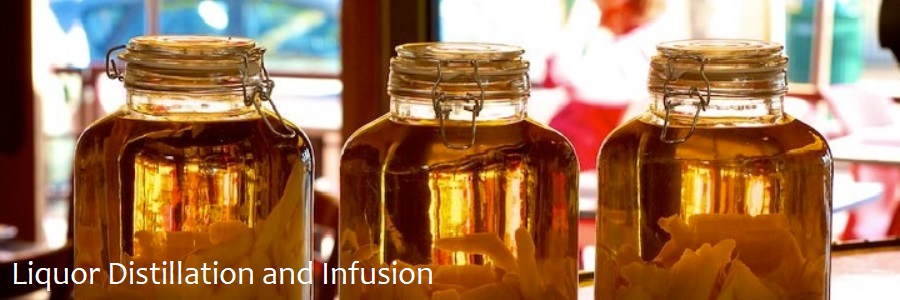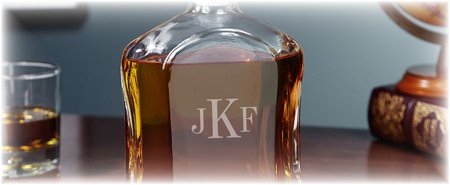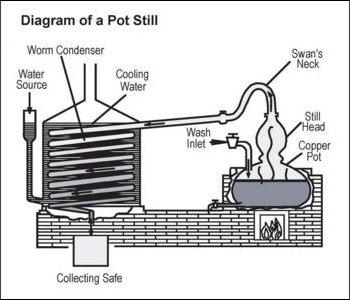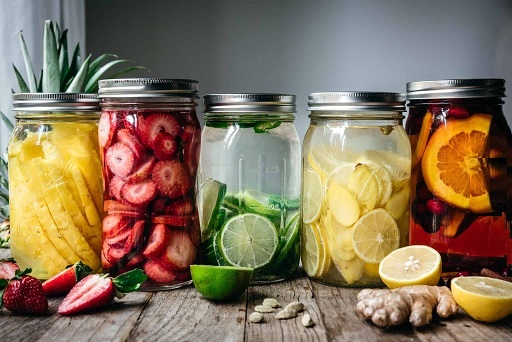
Liquor Distillation and Infusion Guide
Liquor distillation is a universal practice that is enjoyed in all countries. However, it is not a legal practice every where you go, so take caution in knowing whether you are breaking the law or not!
The distillation of liquor and the techniques used vary widely depending on the type of spirit you are planning on distilling.
- Bourbon:
-
 Most
bourbons are made with corn, rye, and barley, a handful of outlaws
defy that tradition with a mash of corn, wheat, and barley
Most
bourbons are made with corn, rye, and barley, a handful of outlaws
defy that tradition with a mash of corn, wheat, and barley - Whisky:
- Whiskeys tend to be rich and diverse in flavors—more so than any other distilled spirits. This can include bourbon whiskeys, scotch whiskeys and the like.
- Vodka:
- Traditionally vodka, gin and other neutral spirits are odorless, tasteless, and colorless. However, more often these days we see the adaptation of flavoring distillation processes for these alcohols.
Liquor Still Distillation Plans, A How To Guide
14 Steps to Distilling Homemade Liquor
-
 Determine
whether its legal to distil liquor in your area, and if it isn't,
you best be hush hush about what you're doing!
Determine
whether its legal to distil liquor in your area, and if it isn't,
you best be hush hush about what you're doing! - Read through our site to determine what type of a still you
want to build or buy based on the type of liquor you are planning
on distilling.
- A POT STILL is a popular choice for distilling Bourbon,
Scotch, Whiskey, Schnapps and other liquors that generally offer
some noticeable flavors. These flavors are generally retained
from the mash in the distillation process.
- Liquor Pot Still Plans - How To Build Guide
- A REFLUX or FRACTIONATING STILL is a better choice for distilling
neutral (flavorless, odorless, colorless) spirits like Vodka
and Gin.
- Liquor Reflux Still Plans - How To Build Guide
- Liquor Fractionating Still Plans - How To Build Guide
- A POT STILL is a popular choice for distilling Bourbon,
Scotch, Whiskey, Schnapps and other liquors that generally offer
some noticeable flavors. These flavors are generally retained
from the mash in the distillation process.
- Preparing a 5 gallon, 18-20 liter wash for liquor distillation.
- Vodka : dissolve 5 kg of sugar & 60 g of nutrients in 20 L of water
- Rum : as per vodka, but use some brown sugar or mollasses, to give an initial specific gravity (SG) of around 1.06 - 1.07.
- Whiskey : Heat 4 kg cracked or crushed malt with 18 L of water to 63-65oC, and hold there for 1-1.5 hours. Heat to 73-75oC, then strain off and keep liquid, using 250 mL of hot water to rinse the grains (should have an initial specific gravity of 1.050).
- Cool the wash to below 30oC, then add hydrated yeast.
- Ferment the wash at a constant 25oC until airlock stops bubbling.
- Let settle for a day, then syphon carefully into the still.
- Bring up to boiling temperature (start the cooling water through the condensor once you get to about 50-60oC), then once it has started distilling; Discard the first 50 mL's (this may contain some methanol),
- Collect the next 2-3L of distillate. Segregate the distillate into 500 mL containers as you collect it.
- Stop distilling once the temperature gets to 96oC (else the flavours get nasty). Set aside any distillate which smells of tails/fusels. This can be added to the wash of the next run, and cleaned up then.
- Turn off the power, then the cooling water. Open the lid, so that it doesn't create a vacuum inside the still & crush it.
- Wash up the still, dry it well, and then store/hide the pieces.
- If you've made a neutral spirit, dilute it down to 30-50 % purity, then soak it with carbon for a week or two to help clean up any flavours still present.
- Dilute it down to drinking strength (20-40%), then age and flavour the spirit, using either commercial essences, oak chips, fruits.
- Find a comfortable spot to sit, put on your music of choice, then sip & enjoy with the ones you love.
A Guide to Infusing Liquor
Once you've completed the distillation process, additional flavors can be infused into your liquor
You can use just about anything to infuse flavor into your liquor - fresh fruit, herbs, spices, dried fruit, and anything else your flavor palate desires. It's best to stick with just a few complementary flavors - don't over confuse it with too many ingredients. Here's a breakdown of simple ingredients often used in these infusions:
- Vodka + Fresh strawberries + Vanilla Bean
- Tequila + Jalapeño + Lime
- Gin + Fresh Ginger + Lemon + Cardamom
- Rum + Fresh Pineapple
- Whiskey + Cranberries + Orange + Cinnamon

Getting started is easy, a bottle of liquor, your flavorings of choice, and a clean glass jar with an airtight lid. Quart-sized mason jars work really well, with an easy-to-seal lid.
The amount of ingredients depends on their flavor intensity. With fruit, you can add a lot, but go easy on the spices and herbs which tend to impart stronger flavors. Too much strong spices like ginger or cinnamon can be overwhelming.
Add the ingredients to the jar, then fill the jar with your liquor of choice. Seal the jar with an airtight lid and store in a dark, cool place until it's ready to strain.
How Long Should Liquor Be Infused?
It depends on the ingredients and type of liquor. Something like strawberry infused vodka can be infused for up to a week or so, the longer you infuse it, the more you will taste the flavors, and the stronger the aroma!
For something like jalapeño infused tequila, too long can be a bad thing, less than 24 hours will do the trick if you don't want to overdo the heat. In fact, if you're heat-sensitive, 10-12 hours is plenty. This can also be said for infusions made with lots of herbs and spices. Opening the jar after 24-48 hours will give you a chance to smell the intensity. If it's very fragrant from the infusion, it's probably good to go. If not, let it infuse for another day or two and check again, 3-5 days is generally a good amount of time for most infusions.
Note: The alcohol prevents any mold from growing on the fruit, so even after you strain it, you can keep it for years.
Strain and Store the Infused Liquor
Pour your liquor through a fine mesh sieve into a jar. If the infusion contains fruit with seeds or pulp (like strawberries), line the sieve with a cheesecloth to remove as much sediment as possible.
Seal and store your final product in a dark, cool place, it will last indefinitely.